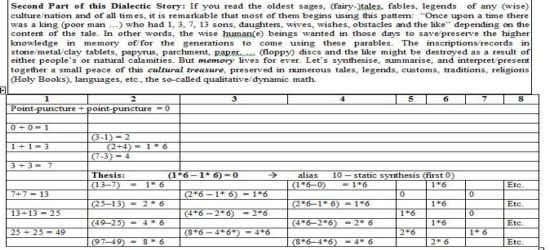DIA
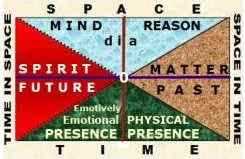
Dialectical Creative Framework for Orientation in the Eternity of Times DIA Infinity of Spaces
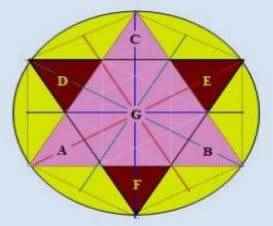
The Endless Dialectical Worlds of a Six-Pointed Star in Time DIA Space understood as endless Depicting a Six-Pointed Star within its Hexagon
DIA: In order to clearly distinguish the dialectical from the rectilinear understanding of time "AND versus DIA" space, a new proposition - conjunction "DIA" was introduced as a replacement for the (recti) linear conjunction "AND". In short, this newly introduced preposition-conjunction "DIA" draws its name from the three first letters of the notion "DIALECTICS". In addition to this original meaning, in the English language, it is also the abbreviation of the developed Dialectic Interactive Approach (DIA). In the symbolic sense which expresses the DIAlectical understanding of time DIA space, "DIA" is graphically illustrated by a six-pointed star [the primary school of dialectics, characterised by the using two dialects (triangles)]. In the everyday language, "DIA" can be approximately translated by a multiple dialectical synthesising of the following words of the (recti)linear comprehension of the TIME AND SPACE: THROUGH, IN, BY, WITH, AND, OR, FOR. In short, the word "DIA" encompasses the basic features, aspects, properties and manifestations of dialectics in time DIA space, such as, transition, transformation and metamorphose, and transfiguration as well, which is the highest achieved dialectical state of all them in time [future, emotively emotional presence dia active and creative physical presence, past] DIA space [spirit, reason dia mind, matter]. As it will be later demonstrated, in the developed dialectic interactive approach, any consideration of the notion TIME without the notion SPACE and vice versa, has no any meaning within the dialectical way of thinking, just due to the previously mentioned basic features, aspects, properties and manifestations of the notion DIALECTICS, respectively of the WORLD OF DIALECTICS, which is in a state of the continuous CHANGE, although in small intervals and scopes of the time-DIA-space it is not always clearly observable. By the way, expressed in everyday-used language based on the rectilinear understanding of space and time, the sentence "dialectical understanding of time and space" is synonymous with its shortened form "time DIA space". On the other hand, the sentence "dialectical understanding of time DIA space" is an additional emphasis on its dialectical properties and aspects.
Because of the all previously mentioned reasons, the DIALECTICAL comprehension of the TIME DIA SPACE has little in common with the (RECTI)LINEAR understanding of TIME AND SPACE. Keep always in mind, the difference between them is NOT IN THE ORDER, in which they were set but in the ESSENCE of their constituent dialects. Thus, if it is still difficult for you to adopt and to become familiar with the notion "DIA", then connect the notions used (in your mind) by HYPHENS, that is, "time-DIA-space" instead of the "time DIA space". In short, the connected notions by the word "DIA" makes an UNSEPARATABLE dialectical whole, where the first notion presents the meaning of this concept, understood in terms of time, whereas the second one presents the meaning of that, understood in terms of space. As an example, you are going to be faced many times with the notion "scenario-DIA-appropriate-situation in time-DIA-space in these creative works and articles, accordingly with the "scenario in time-DIA-situation in space". In short, since the developed dialectical interactive approach is a new methodological approach, this requires by definition use of the additional words, in order to be more precisely defined a scenario in time DIA appropriate situation in space.
So, if you meet the following part of a sentence, such as it, for example, "in terms of least / smallest", the first word "least" elaborates and interprets the meaning of the sentence, understood in terms of time (originating from the notion "little time"), whereas the second word "smallest" expounds and interprets the meaning of the sentence, understood in terms of space (originating from the notion "small space"). If you can speak and understand many languages, you are quickly going to perceive, that all languages, because of being based and developed on the existing (recti)linear understanding of "time and space", when describing a scenario in time DIA corresponding situation in space, they do not clearly distinguish between its time (temporal) and spatial meaning. In addition to this, it is possible the use of dialectical synthesising of more words, in order to be included its more precise meaning, understood in terms of the two additional dialects (the high school of dialectics): Time in space ("future in spirit") and the space in time (the already embedded "matter in the past"). For example, previously were used the words "through, in, by, with, and, or, for" in order to be in (recti)linear terms conjured up the new introduced preposition-dia-conjunction: "DIA".
|
TABLE OF CONTENTS
Go top |
GOOD versus EVIL; Right versus Wrong; Not Bad versus Bad
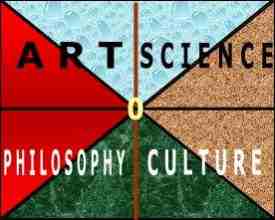
The Background Simulative Methodological Settings of the Dialectic Interactive Approach
DIA
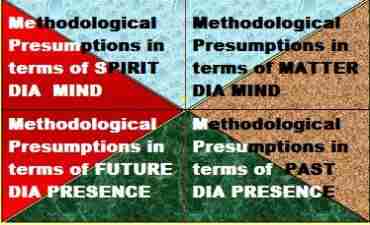
The Ultimate DIA Probable Methodological Presumptions of the Dialectic Interactive Approach
The distinction between Good and Evil plays a central role within the dialectical interactive approach, and is the only dual dilemma retained in this methodological approach. In other words, the lack of a clear, unambiguous, indisputable, and impartial way and method for distinguishing between good and evil is the main stumbling stone, as well as the main cause of related disagreements and disputes when making correct and valid decisions, i.e. making a reasonable conclusion, which will satisfy all and everyone during the (creative) consideration of some dialectical content. In any case, while distinguishing good from evil, every human and human-loving being tries to avoid doing evil to others, first of all, to harm other good people, and then to her-, himself, as well as to try to reduce (and not to increase) the level of evil committed and damage caused in the social environment, as well as throughout the world. In short, evil, bad, and wrong is everything thou commit and cause (pain and evil) to others, but which thou personally do not want others to do to thee.
From this, it follows that not doing something to others that thou would not personally want others to do to thee is a far more universal (generally acceptable) way of distinguishing good from evil, that is, acceptable both in the cultural, artistic, philosophical, and scientific sense. For your valid orientation in time DIA space, unlike this universal way of understanding related to distinguishing Good from evil, the concept of correct versus incorrect is culturally dependent. In other words, what might be right or wrong in one culture (or in some particular social context) might be inappropriate in another culture. For all these reasons, from the point of view of this methodological approach, the distinction between good and evil is more important than any other considered dialectical concept.
NATIOCRACY
NATIOCRACY: The major feature of all natiocratic societal orders [slavery, feudalism, capitalism, communism, socialism, debtism] is misuse of the notion NATION [HEREFROM ORIGINATES THE IRONICAL NAME OF THIS ESTABLISHED POLITICAL SYSTEM: "NATIOCRACY"], demanding the sacrificing of all and everything in its name and behalf, including its citizens. By going in a methodological way behind this dialectical content, it is not difficult to be recognised the hidden narrow-minded interests of members of the ruling natiocratic elite. As a result of this approach, IN EACH established natiocratic societal order, the main role plays and thus makes decisions about all important for the society as the whole, A FEW PERCENTAGES of its inhabitants (elitist upper castes).
Natiocratism is based on the (recti) linear understanding of space [FUSED MIND, matter] and time [past ⇢ PRESENT ⇢ future], the consequence of which is the dual [AND - AND] → bipolar [OR - OR] DIA chosen [OR] binary way of thinking: Yes - No, Truth - Lie, Black - White, With Us - Against Us, Everything - Nothing..... which all taken together leads to the rule of the way of thinking of the mob organized into numerous groups. In short, in this way of organizing social, economic, and cultural-religious collectives, there is not (enough) room for the individual way of thinking. Moreover, bickering, arguing, pushing, fighting... including the resolution of related problems and conflicts at the level of the mob through war is embedded in the inner beings of the adherents of this bipolar way of thinking. For this reason, the implementation of the selected binary OR option, both at the individual and group and mob level, is their natural and innate way of resolving mutual disagreements and disputes, if the peaceful but temporary postponement of these disagreements and conflicts for a while is exempted. In short, seen from an individual, humane point of view, this postponement will last until this negative emotional content (charge) in their inner beings accumulates again, that is, until this "cup of gall" is again spilled on someone " (through the negative emotional or evil-spiritual venting and emptying of theirs).
The previously mentioned violent, bipolar resolution of disagreements and disputes at the individually - dual level manifests itself in various types of duels. On the other hand, although the grouping begins at the dual level, this type of conflict (of interests) continues with further grouping and classification of people on two opposing poles of this imaginary (bipolar) line. This kind of dueling and grouping can be better illustrated with two proverbial, stubborn goats on a log, who simply do not want to let each other cross the log, further encouraged and supported by their supporters, ideological followers, who push their leader and idol, which is followed with the well-known natiocratic shouting, noise, and shouts, while they try to push their candidate over the log.
Although at this stage of the formation of natiocratism, depending on the established natiocratic societal order and the chosen natiocratic political, economic, and cultural-religious way of organizing society, as a form of implementing natiocratic rule, disputes are taking place on a large number of these "logs", as well as on various levels of social organization, they have in common that they follow the further process of mobilizing and crowding people like it is about a herd (abusing the concept of nation) as the most important stage of the establishment of natiocratism, which is in accordance with the adopted natiocratic ideology, as a counterpart to individualism through further and further humanization (of the inner being).
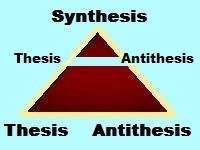
Natiocratic Pyramid
In short, although in this phase of grouping people (citizens) it is much easier to remain unaligned, whether because for one reason or another you do not want to align yourself, or you are simply in doubt as to which flock to join, during the crowding and herding process it is much more difficult to avoid, especially if you are not ready to pay the appropriate price due to some individual, public form of opposition and confrontation. In any case, within natiocratism, non-alignment means that not only will thou not advance on the social, political, and economic ladder, but thou willst have a hard time maintaining thyself on the existing social-economic ladder. For this reason, the previously described bipolar collisions, oppositions, and confrontations at this group level of solving problems and disputes should not be taken literally in a binary sense, that is, that (All OR None) must end in this way in order to begin the natiocratic phase of crowding and herding people around the concept of nation, as well as that everyone must participate in this type of bipolar contests of various groups gathered around the respective political, economic, social, and cultural-religious programs.
In any case, at a pre-arranged signal (the sound of a siren, a bell, the announcement of the results of the competition, or the news that the supreme ruler has died or been replaced...), all participants in this group competition will from that moment focus all their attention on taking timely their fetched position, or otherwise earned position within a separate ruling apex
- The "Lesser" Natiocratic 'Heavenly' Pyramid, that is, if you are not good at pushing your nominee candidate physically, perhaps you are more skilled in natiocratic clambering and "mountaineering"
from this "bigger" flatted ("headless") pyramid (mastaba without SYNTHESIS, that is, without the possibility of making important or valid decisions) intended for barren discussions of wider masses of people, characterized by a multitude of theses and antitheses expressed in the form of various disputes and quarrels that are beyond the scope of common sense, that is, emotional discharge: endless "tavern" discussions and empty stories without content. In other words, only within this separate 'heavenly' pyramid intended for the ruling natiocratic elite is the classical dialectical method (thesis, antithesis, synthesis) applied, that is, making decisions that can hardly, or not at all, be contradicted or replaced, which depends on applied natiocratic form of government.
Dialectul
DIALECTUL: Thy presentation DIA interpretation of a dialectical content uttered and understood in terms of the least (smallest) in dialectical comprehension of time and space. For example, during undertaking a creative traveling in time DIA space, thy individual abilities to break up these inner and outer dialectical contents of the time dia space into the smallest pieces as it possible (dialectuls), and then again to put together, rethink, transform, recompose and re-design it, by synthesizing this puzzle of dialectuls in a dialectical creatively interactive way into a meaningful creative whole (thy creativity) is in fact of crucial importance in this methodological approach and the way of creating (a new dia deepening an existing) knowledge.
I ⇄ THOU ⇄ WE

Couple Dialect: Thesis DIA Antithesis
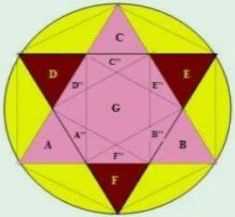
Synthesis DIA "G" → The Renewed Thesis in the Time DIA Space
ETC. in the Time DIA Space UNTIL

"G" → The Temporary Conclusion of Time, in the Time DIA Space is reached
I - THOU - WE: In order to be clearly distinguished the crowd dia group way of thinking from this presented humane, creative, individual way of thinking it was introduced this notion (I ⇄ THOU ⇄ WE). In other words, in full agreement with the developed dialectic interactive approach [thesis, antithesis, synthesis DIA THE RENEWED THESIS... a myriad of ANTITHESIS.… until a temporal conclusion in (of) time DIA space was achieved] only by using this concept can be satisfied the major postulates of this methodological approach. Recall, this methodological approach opens doors for a THIRD, fourth,…. way, as an antithesis to the current ruling bipolar DIA binary approach: black – white, yes – no, for - against, all - nothing, 0 -1, and the similar.
As a result of it, the expounded black or white ‘WE’ way of thinking is not at all in accordance with the dialectic interactive approach because this represents a way of speech and expression in "the name and behalf of all", including those who do not agree at all with the expressed content, primarily applied within the sphere of creative activity and freedom of expression and choice. In short, this widespread mode of expression that is present at all levels of modern natiocratic social organization can be reduced to a formal sentence: THOU or YOU have the freedom of choice to do what you want, and to say what you want in the places that WE have designated [for example, during public demonstrations or protests], but at the end it will come down to what WE have already said, what WE are saying and the option WE have chosen "in the name, for the good, and for the benefit of all of YOU". In short, translated into everyday language: "in the name, for the good, and for the benefit of the respective natiocratic elite whose interests are represented".
This creator of knowledge has been fed up with the empty catch-words for the grouping and crowding of people by using this simple-minded and simple-reasonable way of thinking, such as, for example, ‘(ALL) WE humans’, all people are good, 'WE' together will do it… and the similar, because the use of common sense clearly says that there is no such ‘we’ societal categories, that in this particular case means, we are not all humans (and good), NOR the majority of people are good, because in that case, this world would be completely different, seen from the standpoint of distininguishing Good from evil. In short, this creator of knowledge clearly distanced himself from both of them and especially, from such a way (in essence malign, or EVIL) of thinking, which will neither change something on this endless rectilinear dia binarily bipolar line of this way of comprehending of the time and space NOR will lead these nations and the established social communities and colectives in the right (GOOD) direction. In other words, seen from the methodological point of view, this simple-minded way of thinking provides a foundation for the various forms of the natiocratic societal orders through initiation of suitable political systems (STATUS-QUO: Spinning in this vicious circle of natiocratism).

Dialectical Creative Framework for Orientation in the Eternity of Times DIA Infinity of Spaces
VERSUS
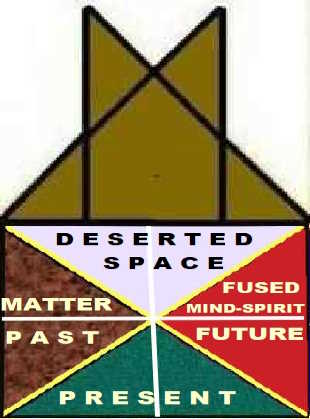
Methodological Reasoning DIA Comprehending of the (Recti)linear Space and Time, understood AS SOMETHING OUTSIDE US
Concluding this initiated dialectical process, I ⇄ thou ⇄ we, simply means, only in the case, thou (and thou, and thou, and …..) agree with me DIA until I - THOU – WE agree and understand each other in regard with a dialectical interactively creative content under consideration, using the methodological means of the developed dialectical interactive approach [CLASH OF IDEAS AND THOUGHTS instead of using various means of the natiocratic power], thereby distinguishing good from evil. For example, at least like in the antique age, within the narrow circles (of philosophical debates) of Socrates (dialogs), or even better like the major actors of the Book of Job (multi-dialogs), each of us can speak in this conversational form. However, if someone leaves an established actor-net, for any reason, in order to be established a ... fifth, sixth…. way, it is still in accordance with the basic postulates of the dialectical interactive approach. In short, all other pathways are acceptable, understood in terms of distinguishing good from evil, apart from the returning to the bipolar DIA binary way of thinking. Probably, you have already taken notice, that it was also re-introduced the notion of THOU instead of YOU in order to be broken apart in this way as well, the aforementioned natiocratic process of alienation. In short, by using this form of conversation (in fact, a distance and alienation), people became not more equal. On the contrary, by using at the first sight this polite form of conversation, acquired without a deeper methodological insight, they became in this way even more alienated of each other.
This creator of knowledge has already been faced with remarks that this (I ⇄ thou ⇄ we) way of communication IS NOT POLITE [what is a positive awareness, meaning they at least had read what I wrote], but most of the ordinary people were “shut up” wenn they were contradicted by a simple question: Which type of conversation do you use when talking with your mother, father, close friends? After they answered that it was used the Thou way of conversation, I closed them up with the following question: Why then do YOU not use this 'YOU (POLITE, GOOD) form' of the conversation, if it is truly better and more polite, when talking with your parents, instead of using it during a conversation with not well known persons?
- It should be noted here that this is about the application of methodological procedures and techniques of the dialectical interactive approach during a creative discussion, and especially during the creation of new knowledge, i.e. deepening of existing knowledge, where the main role is played by the strength of arguments and not various types of application of natiocratic force and power. In order to put this postulate of this dialectical interactive approach into practice, it is necessary for all participants in the creative discussion to open these dia-processes from an equal starting point, that is, to leave their social status aside. This was the initial idea and motive for the development of this methodological approach.
- Since this Human, Creatively Individual Way of Thinking never got a chance on this strictly controlled natiocratic creative scene, that is, it never took off, don't get carried away inspired by the above to try to apply this in natiocratic practice, if you haven't ready to pay the appropriate price, especially during the conversation with your superior. Moreover, a human being in this harsh, mistrustful, natiocratic environment cannot even want to start a conversation with strangers in this humane, individual way.
- It also follows from the foregoing that as a consequence of the merged and fused mind and spirit in conjunction with the concept of (recti) linear space and time, understood AS SOMETHING OUTSIDE US, it is not easy to differentiate between potential reality [time in space: Now and There] and reality [space in time: Here and Now], that is, between the potential concept (I ⇄ thou ⇄ we) from the existing, actually embedded in the past We - You way of thinking and expressing. It should also be emphasized here that the existing concepts of space and time were developed for the purpose of their application in the field of natural sciences (the physical universe, for example) and culture and religion (Ptolemy's understanding of the universe), and not for wider application in the field of social sciences. To cut this long story short, the dialectical understanding of time and space is also applicable in the social sciences, as previously demonstrated by the application of its two key concepts: space in time [matter already embedded in the past] and time in space [potential future in spirit, that is, still invisible, and (to a considerable extent) present in reality].
- In short, without this Human, Creatively Individual Way of Thinking and Deliberation, which is embedded in the dialectical interactive approach, there is no way out of the world of natiocratism. In other words, the ultimate purpose of this previously mentioned about "You" way of communicating is to prevent the incorporation and wrapping of the old way of thinking in this new way of thinking and deliberation, for which the natiocrats are real specialists.
- Starting from the fact that this methodological approach is based on an individual way of thinking, in the dialectical interactive approach there is no place for either "WE" or polite "You" way of expressing and thinking. Paraphrasing Christ, "....do not allow new wine to be poured into old wineskins" (Mark - 2:21-22) if you do not want this new "wine" to spoil through transferred, insidiously wrapped and skillfully incorporated linguistic concepts in the old "wineskin", that is, in the structural platform of the dual → bipolar dia binary way of thinking.
Either way, the process of individualization DIA HUMANISATION understood in terms of treating other HUMAN BEINGS as thy sisters and brothers, can not be initiated with the continuation of the use of WE dia YOU form of conversation during an interactively creative dialectical debate, because the most of the time will be spent on prevailing this INHUMAN distance (if you dare to contradict them!), which is a distinct FEATURE of theirs. As one example, consider again the tragic fate of Socrates in terms of one ultimate outcome of having a "dialogue with the omniscient" mighty men of democratic ancient Athens.
Or put it in another way, they DIA their inner personification of them will continue to lead the main word during such a kind of (the creative) debate, in this old-fashioned manner, which characterizes this kind of ‘WE humans’, while leaving YOU to satisfy yourself with this cheap reward of You-way of "speaking to". Keep in mind, each TRULY human(e) being for the difference to them has only ONE inner being DIA inmost being, and not two, three, four (‘faces, masks…’) as they possess it. Or as once upon a time, they said to Christ: There are many of us (inner demons) ….. [and for this reason, you have to address and greet all of them, haven't you?]. On the other hand, in accordance with the dialectical interactive approach, all involved human-loving actors (creative) discussion, since there is no previously mentioned inhuman "YOU" nor absolutistic "WE" distance, strive after each initiated dia-process to match and harmonize their expressed theses and antitheses so that it could be validly dialectically summarized in the sense of a multitude of renewed theses, and so on, until a temporary conclusion of this dialectical understanding of time and space is reached.
Dot
DOT: Unlike general (dynamic) mathematics [expressed in terms of emphasizing space], in dialectical mathematics (expressed in terms of emphasizing time) zero (0) does not equal "nothing" in the absolute sense but a dot, because it is the result of the accumulation of invisible but imaginarily imaginable dialectuls: Thy presentation or interpretation of that dialectical content, expressed and understood in the sense of the least (smallest) in time DIA space. In other words, with the aforementioned, a sufficiently large accumulation of invisible pores-spores within this dialectical understanding of time and space was imaginarily presented, which enables the emergence and appearance of a visible dot, that is, visible whether with the naked eye or with some auxiliary instrument. Keep in mind, following the dialectical way of thinking, nothing within the dialectical world of His can exist or be created without the existence of both the mega-dialect time and the mega-dialect space. In short, understanding of time and space in this dialectical way enables a continuous source of change, which is again a dialectical assumption for the origin and existence of life and everything else in a deeper, further, and broader sense of this notion.
Line
LINE: Since this accumulation of dialectuls in time DIA space takes place in the sphere of visibility with the naked or "aided" eye, sooner or later some kind of DEVIATION will appear in the dialectical medium of time and space as a result of the interaction of time in space (the future within the spirit: NOW and THERE ) and space in time (embedded matter within the past: HERE and NOW), perceived as the outlines of a dotted line in this particular case under creative consideration. Since also in the dialectical sense the point next to the point, in the sense of the geometric representation of the previously mentioned deviation in time DIA space, is already a line, the smallest visible [not in physical manifestation, since it is relative in the sense of the smallest in the eternity of time DIA the infinity of space rather in the sense something concrete], but still a recognizable line, regardless of whether it consisted of two (minimum), three, ... three hundred, ..... (billiards) dots. Note that this counting of points makes sense in dynamic (quantitative) mathematics, that is, there is enough time and space [time and space are made static by "trapping" them within a line], but not (time DIA space) in dialectical mathematics due to constant changes, and therefore according to this way of mathematical calculation 0 (dot) + 0 (dot) = 1 (line). In other words, in dynamic (quantitative) mathematics, only the final quantitative outcome is registered understood in terms of physical space, while the dialect of time is completely neglected and forgotten. Only an experienced dialectician can perceive that the quality in terms of time was PREVIOUSLY present within this line, before it was forgotten. By the way, this dialectical content can still be sensed in the geometric representation of the number one [1: one manifestation of a non-closed triangle ⇢ number one (1), represented as one vertical downward-facing angle].
To get an even more complete dynamic representation of the above, imagine one apple (1) on a tree (dot), then one (1) living being or robot (dot), and her/his (automatic) hand extended in the direction of the apple (line), in order to overcome the perceived deviation in time DIA space, and picking it up and moving it back (WITHOUT EXPRESSING ANY EMOTION or EXCITING) to put it in the basket. And while (that or another) apple [it's always about quantity and not quality] is in front of thee on the table, all this qualitative (emotional and feeling) story, understood in terms of time DIA space is simply forgotten or neglected. In other words, the qualitatively expressed story, how it got to thy table, cannot be expressed in terms of dynamic (quantitative) mathematics, because that is not its purpose. In short, this static dynamic story can only be expressed with some kind of qualitative mathematics, that is, with this simplest manifestation of dialectical mathematics. On the other hand, it is very important to emphasize here that this QUALITATIVE content will only be deeply imprinted with a strong emotional "touch", and as such will be preserved in time DIA space [and not this quantitative content, except perhaps temporally be imprinted and memorized in thy mind dia reason].
Triangle
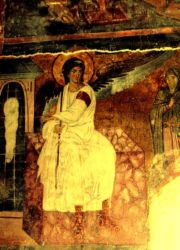
TRIANGLE: Any manifestation of the dialectical trinity or triad (thesis-antithesis-synthesis) can be symbolically represented with a triangle, as the simplest expressive surface in which more (occupied) time DIA corresponding space can be "trapped", i.e. a higher quality (DIA filtering of it) can be preserved, and which otherwise could not be placed and preserved in a (recti) linear form as "TIME AND SPACE" [that is, within this imaginative line]. In other words, this higher quality would be lost, because this dialectical interactively-creative content cannot be encompassed by an (imaginative) line, rather, one could say, it would be scattered, i.e. dispersed through its two BINARY ends due to invisible tensions within this line. If this is summarized (synthesized dialectically) with the previous statement regarding the point and the line in the sense of dialectical mathematics, a triangle is obtained with the qualitative joining or closing of the two lines. On the other hand, the creative outcome of that same dialectical content in the quantitative [(recti) LINEAR] sense is an angle. And finally, with the dialectical summarization of this dialectical interactive content in accordance with the previously presented way of dynamic DIA dialectical way of calculating in time DIA space: 1 (line) + 1 (line) = 3 (triangle).

The Symbol of the Human(e) Genus
The previously mentioned apple picking with stretching out (forward) and pulling the hand back, in order to put the picked apple in the basket, can perhaps be represented graphically with one (↔) or two arrows (⇄), understood in terms of a rectilinear understanding of time AND (physically staticized) space, but not in the sense of dialectical mathematics because of the well-known DEVIATION in time DIA space, no matter how small it may be. Remember, nothing stands still within the worlds of dialectics. For example, in this particular case, the earth continues to rotate around the sun at a speed of 107,000 kilometers per hour, and the sun also rotates within its local constellation, etc., regardless of whether thou or you are apparently standing still or moving. In other words, it will all be registered within this dialectical understanding of TIME AND SPACE, and as such for the purpose of describing this dialectical DIA dynamic process [from the goal (apples on the tree) to the apples in the basket (destination)] will be represented by two diagonal lines symbolically connected in a triangle. It should be noted here that all this depends on the point of view from which you consider this dialectical content, which evokes this "down to up DIA up to down" movement in time DIA space. In any case, seen from a dialectical point of view, an imaginative triangle will be created, within which, this higher quality has already been preserved or can be preserved. Even in this simplest manifestation of dialectical mathematics (synthesis DIA ....) within this dialectical relation (or interplay if you will) of dynamic mathematics (thesis) and this form of manifestation of dialectical mathematics (antithesis) in time DIA space, within this dialectical content there is still "too much nested rectilinear way of thinking, seen from a dialectical point of view, that is, too many unnecessary repetitions (redudance).
From the point of view of dialectical mathematics, the first thing that is visible is that in terms of the time DIA space spent for this dialectically more qualitative relation, two lines are not necessary, but rather one line and a point. In other words, with the simultaneous (so that the quality does not escape) imaginative "drawing" of two lines from these two landmarks of the dialectical understanding of time and space, a triangle can also be formed. In fact, this even more faithfully represents the encompassed, grasped, and captured time DIA space within this imaginary triangle. In order to achieve this goal, this dialectical creatively-interactive content can be presented even more qualitatively with a self-reflective connection, that is, a dialectical summarization of the three (invisible but imaginable) points of this triangle within this dialectical understanding of time and space!
|
|
In other words, similar to a child who uses abacus or fingers to understand or make sure that in terms of dynamic (quantitative) mathematics 1 + 1 = 2, so does someone who is new to the field of this simple dialectical (qualitative) mathematics, [but the same does not apply in the area of a higher dialectical mathematics], is now able to imagine how or why 1 + 1 = 3. In real life, that is, the practical application of this previously expressed dialectical content, all this is not at all something new. It is admirable, how a human being is able in a flash of time DIA space to intuitively imagine, conceive, conceptualize, and then to summarize some dialectical interactively-creative content, using his mental (emotiv) emotional intellect. This kind of picturesque dialectical representation and interpretation of time in space (NOW and THERE: apple on the branch) DIA space in time (HERE and NOW: apple in the basket) in the sense of this dialectical understanding of time and space, is probably closer to the abilities (and possibilities) of some imaginable supernatural (artificial) intelligence, primarily its technical part.
The exception may be children (from the countries of the Far East) who have been (re)taught to think and create something by applying some related type of pictorial way of thinking and presenting dialectical interactively-creative content. It's no accident, according to this experienced traveler through time DIA space, that a large number of innovations, both in the written past and in this modern age, were precisely designed creatively on these "pictorial" expanses, because in fact one of the characteristics of any creative form of creation is using its innate creativity, and it is imaginary, i.e. imaginative the dialectical summarization of the outlines of the imprinted images in the (human) mind dia reason by means of spiritual, emotiv-emotional presence, applying as a minimum the sense of presentiment and premonition DIA the inner feeling of already being spiritually present in this encompassed time DIA the appropriate space. Or to put it another way, this dialectical creatively-interactive content is filtered through its inner DIA innermost being, used as a kind of dialectical sieve placed in one constant progress, understood in terms of the initiation of multiple and multifaceted dialectical interactive processes within this eternity of times DIA infinity of spaces [undertaking appropriate creative journeys in terms of time in space (future in spirit)], expressing this dialectical content in sense of the littlest / smallest (dialectul of the encompassed time,) in time DIA space.
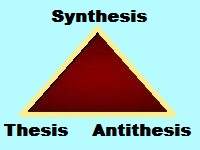
The End Result of Applying the Concept of Absolute Truth within the Rectilinear Understanding of Space and Time
This level of achieved development of dialectical thought, or more precisely its revival, was used in the 19th century to develop the classical dialectical model of reality represented by the triad of thesis, antithesis and synthesis, correspondingly represented symbolically and graphically with a triangle. Although this methodological approach was a great step forward in the era of the embodiment of the suitable philosophical way of expression, the classical dialectical model of reality failed to break away from the constraints of a straight-line way of thinking and the corresponding straight-line (rectilinear) understanding of space and time. The end result of this classical dialectical method is the emergence and manifestation of a form of absolute truth (dogma) that is very difficult to contradict, and especially to change, because this methodological approach does not provide a clear methodical way out of this form of manifestation of the devil's triangle. In other words, there is no way to resolve this undesirable scenario in time DIA appropriate situation in space without some form of manifestation of force and coercion. Since, seen from a dialectically long-term perspective, some form of manifestation of change will always prevail, the accumulated and increased disagreements caused by these dialectical changes will try to be resolved within this limited rectilinear space and time by a dual → bipolar dia binary way of thinking, already hidden within the lines, which limit this triangle.

Paired Dialect: Thesis DIA Antithesis
DIA

Synthese (Six-Pointed Star) DIA its Hexagon "G" → The Renewed Thesis
ETC. UNTIL the Temporary Conclusion of this considered Time, in the Time DIA Space, is reached
In order to shorten this long story, within the transience of the dialectical understanding of time and space, i.e. the continuous transition and transformation of initiated dia-processes from one state to another, even this form of triangular manifestation of a lonely "island" will not be spared from the effects of the resulting dialectical changes. In the next creative article, more will be said about these METHODOLOGICAL INCONSISTENCIES and the shortcomings of this classic dialectical methodological approach. For this reason, in order to avoid the pitfalls of this rectilinear understanding of space and time, in the dialectical interactive approach, the thesis and antithesis are represented by two congruent triangles, which will be dialectically synthesized by the flow of the dialectical understanding of time and space, in the form of a six-pointed star DIA its hexagon (renewed thesis) and so on in time DIA space UNTIL the Temporary Conclusion of time, in Time DIA Space is reached. In other words, in accordance with the previously presented method of dynamic DIA the corresponding dialectical method of calculation within the dialectical understanding of time and space: 3 (triangle) + 3 (triangle) = 7 [basic school of dialectics: six-pointed star (6) dia its hexagon (1': new contained quality), within which a higher quality was preferably transferred and preserved for further continuation of the started dia-processes].
Reviving of the Dialectics
THE REVIVAL OF DIALECTICS: The German Kantian, Johann Gottlieb Fichte (1762 - 1814) was the first thinker in modern times DIA space, who presented DIA interpreted the dialectical way of thinking as a triad of thesis, antithesis and synthesis. In other words, he laid the methodological foundations of the classical dialectical methodological approach. After him, many other thinkers, to a lesser or greater extent, put dialectics under their creative consideration, thereby contributing to the further development of this classical dialectical methodological approach from the 19th century. Most of them were born in these German expanses, which were at that time DIA the corresponding space much more decentralized, with linguistically richer ways of expression DIA culturally far more diverse, and thus by definition, creatively freer spaces (spirit, mind dia reason, matter). The greatest achievement of this creative interaction is the definition of three basic dialectical aspects and principles. Of course, with the unification of numerous principalities and kingdoms into the great German Empire with the aim of (belated) pursuit of world imperialist goals, which characterized the surrounding empires at the time, dialectical way of thinking DIA corresponding worldviews was abandoned and replaced with more appropriate philosophical guidelines. In other words, the revival of the dialectical (interactive) approach, understood in the sense of considering this dialectical content from the standpoint or the point of view of various German philosophical directions (at that time ruling in the world framework), so characteristic for this time period DIA more creatively decentralized spaces of the flourishing of German philosophy, culture, art, and a little later science too.
Creative Works:

- "Netmode – the Strategy for 21st Century – Dialectic Interactive Approach, Jovanović, Denmark - Copenhagen, May - August 1999"
- "Traces of Dialectics in Time DIA space – Methodology for Creating Knowledge, Jovanović, Denmark - Copenhagen, February - May 2001"
- "World of Dialectics versus Multidimensional space – Dialectic Interactive Approach in Use, Jovanović, Denmark - Copenhagen, May 2002 - 20??":
- - Appendix 1: More about the Fourth Dimension , England - Manchester, November 2002
- - Appendix 2: The Eternal Poem, Germany - Aachen, August 2003
- - Appendix 3: The Book of Job - Holy Bible, Austria - Salzburg, February 2004
- - Appendix 4: The Human (Re)Enlightenment DIA Divine Choosing versus The Natural Evolution DIA Natural Selection, Germany - Münster & Nürberg, October 2004
- - Appendix 5: Implications of the Implementation of the Concept of Simple(st) Mind in terms of the Theory of Natural Evolution DIA Natural Selection into Living Reality, Germany - Nürberg, November 2004
- - Appendix 6: Holy Scripture: The Teaching of Buddha – Vakkali Sutta, A Fragment for the Initiation of Dialectic Interactive Process, Netherlands - Rotterdam, March 2006
- - Appendix 7: Feodosian Spring Rhapsody, Programming in Java – A typical earthly creative Travelling: A short Fragment from this Travelling for Initialisation of a deeper Dialectic Interactive Process, Ukraine - Feodosia, May 2007
- - Annexing 7-1: Concept of the Free Will DIA Freedom of Choice versus Wisdom of God, Netherlands - Rotterdam, August 2008
- - Annexing 7-1: Natiocratic Concept of Secularism versus the Distinguishing and Separating DIA Discerning and Recognition Good from evil, Netherlands - Rotterdam, August 2008
About Website Portal:

The first internet portal, bobovirtual.com, which included these creative articles, was developed in the year 2010 in Riga, Latvia. On the other hand, the portal's subdomain such as, for example, /apartments/lv/riga/salacas written by java programming language (after acquiring Sun-Microsystem by Oracle, it cannot be opened), were developed much earlier, at the end of 2007 in Rotterdam, Netherlands. The most of the creative articles such as this one you are reading now, were also compiled during my stay in Riga, Latvia (2010), and only a few of them were compiled in Evpatorya & Sevastopol (Ukraine) and Kishinev (Moldova) at the beginning of the year 2011. After an unsuccessful try for hosting this website portal by an internet provider in Sevastopol, only the client side of this java applet was launched in Kishinev (march, 2011). In the meantime, these original creative articles have been updated and expanded, and new articles have subsequently been written and put online.
READ the Next Part of this Article:




